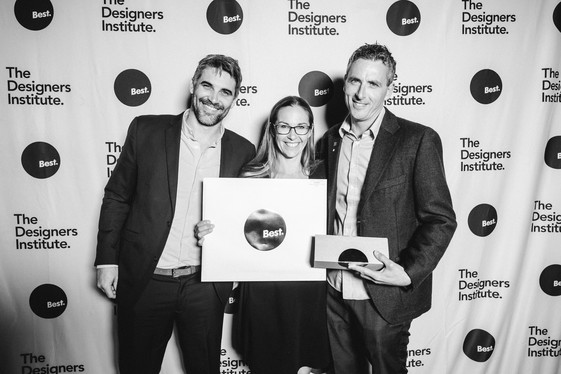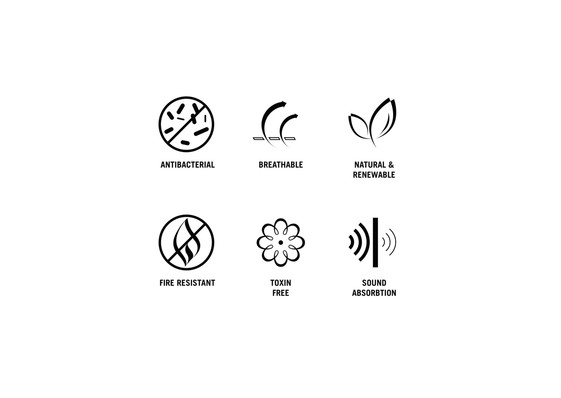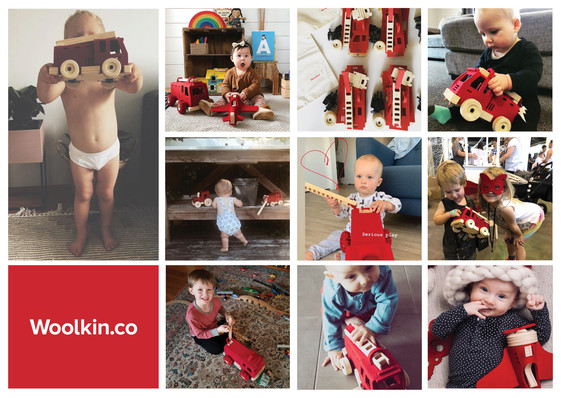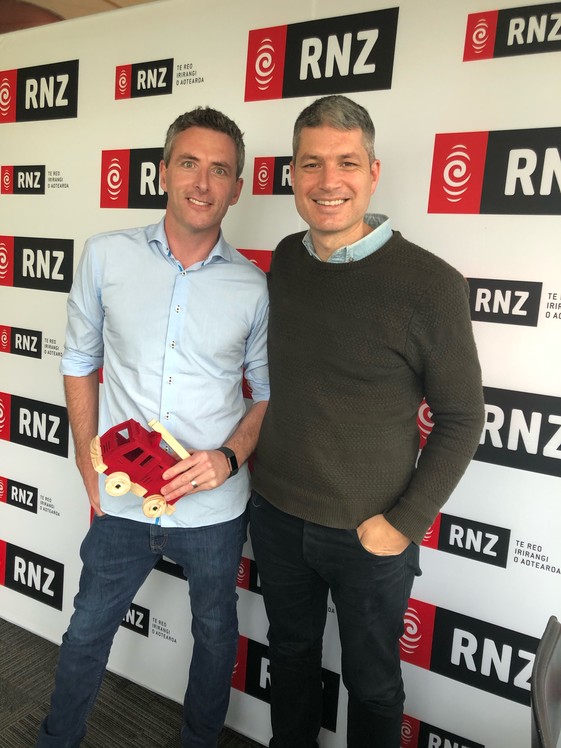To lift our days during this time, each week the Designers Institute will release a case study on a Best Design Awards 2019 Purple Pin winner
– a project description in the words of the designers along with a short interview with writer Mike Barrett.
Purple Pin Case Study — Product
Woolkin
Brave Dave - The Fire Engine
Product: Brave Dave - The Fire Engine
Studio: Woolkin

The world’s most renewable kids toys
Project description
Jesse Mulligan on RNZ described Woolkin as “the Allbirds of kids toys” and OneFineBaby described ‘Brave Dave’ as “one of the world’s most renewable kids toys”. Both apt descriptions for a company and burgeoning range of toys that puts responsible production, natural materials and the innovative use of wool on par with surprise, delight and good clean fun.
Brave Dave, this year’s Purple Pin winner for product design shows how when it comes to toy design, you can make a clean break from mass produced, toxin-loaded, easy-to-break, unrecyclable and, in some cases, unsafe toys that seem prevalent today. At Woolkin there’s a passion for play – and the importance of growing healthy imaginations sits at the core of these natural, nature-inspired toys.
Brave looks cool. It’s chunky, bright, bold and robust. It’s tactile too, which is important because we learn first through touch, feel and kinetics.
Because touch is a key to development, materials really matter. Brave Dave is made from Naturesclip™ – a new New Zealand-wool material system also designed and engineered by Woolkin. It’s wool, but not as you know it – along with natural untreated FSC-certified timber from Aotearoa forests, and clips derived from the dextrose and polylactic acid of plant starch

Q&A
Mike Barrett talks to Blythe Rees-Jones, FDINZ & Co Founder Woolkin
Hi Blythe, shall we knock off a general question first? How did you get into design?
Design came naturally to me. As a kid I was always drawing, painting, building things and taking things apart. I love the creativity, mechanics and materiality that comes from this, and running with your imagination when you are trying to solve problems. When I was 14 or 15, my older brother Glyn, who’s now a lead product design engineer at Dyson, came home from design school in Wellington and showed me some of his work. I was like, “wow”. It looked so cool, and that was it, I knew what I wanted to do.
In sixth form I started working on my submission portfolio to apply to get into the same Bachelor of Design course in Wellington as my brother. I’ll never forget receiving the letter in the mail offering me a place in the course – it was like winning the golden ticket. Studying industrial design, I became curious about design processes. I loved the studios and workshops; everywhere I looked interesting questions were being asked and great ideas were being conceptualised, prototyped and presented. I started to explore biomaterials and sustainability, and the human factor for why some products really work and succeeded, when others do not.
In my third year at Design School, I designed a cooker, which went on to win the student prize at the Best Awards. It was a cool moment. I remember Tony Parker (then head of school) came and got me out of class and told me to pack an overnight bag – I was off to the awards in Auckland. I owe so much to Tony, Amanda Wilkinson (my tutor for the Cooker project) and all the other tutors and designers whom I have had the privilege learning from – you all know who you are – thank you!
As I entered the professional world and honed my skills, my passion grew towards using design as a powerful enabler to do good and champion the use of renewable materials and responsible processes. I wanted to put our uniquely antipodean resources to use.
Who’s involved with Woolkin now?
I co-founded Woolkin with my wife Anna and good friend Luke Morreau. Today our team is growing. Like many good ideas, this one came together through a series of separate events that began to converge.
Firstly, our team always wanted to create an iconic New Zealand product brand, something that drew on our uniqueness and way of life. Secondly, my other brother Hayden gave me a stir-up one day about wool and how bad a shape the industry was in. He believed it was a design problem and called me out on it, saying: “You’re a designer, come and fix it!” I’d been exploring wool as a product design material for a while but after that call things got serious! And thirdly, Anna and I had started having kids, as had Luke and his wife Denise, and we’d entered a whole new world of parenting. As designers, we were surprised by the lack of quality designed products available and shocked at the excessive use of synthetic materials.
And then all that stuff just started turning up as it does when you have babies in your house. Many of these materials are simply not fit for young lives. Our motivation became trying to design a way out of this situation. As these separate thoughts collided, Woolkin began to emerge.
So fixing the wool industry, providing an alternative to the glut of crap that swamps a house with kids in it, and creating something that could be as iconic as the buzzy bee. That’s a nice high bar.
For us, it really felt like the right answer was to move the lives of littlies forward sustainably. Globally, New Zealand is known as a country whose people have a love of nature and spirit for adventure. These qualities translate well into designs for young lives. Plus, we come from a country with a rich wool story. As Naturesclip took shape, we realised it was the perfect ingredient for making baby and kids’ products.
After a few stumbles we landed on a name and brandmark that embodies the vision and has potential to scale globally. Woolkin speaks to these strong natural, environmental and lifestyle values. Our first product was the Sleepnest®, a beautiful pure, natural baby bed. This gave us our start. From sleep, we started to look at tackling play, real play, and entering the global toy market. This meant setting out to create designs that could culturally rival the bee, or those famous plastic dolls, plastic construction blocks and, hopefully, resonate with the future generations who will champion natural values.

Interestingly, on your website, it’s the Big Red Tractor that’s sold out and not Brave Dave. Do you think the judges awarded the wrong product?
Haha…you don’t miss a thing! The Big Red Tractor, along with all the other heroes, is pretty popular, so maybe the judges did get it wrong! You would have visited the site on a busy day! We only entered Brave into the Awards. Maybe we will have to enter the other characters and let the judges decide!
Jokes aside, I guess the obvious question is, why a fire engine?
Good question! A toy fire engine is a universally loved object that transcends ages and cultures. To inspire and show the world it’s possible to naturally clean up the playroom we knew we had to go for a centrepiece with ubiquity – but we also had to make it quintessentially new. We jokingly coined this “newly familiar”. We designed Brave Dave with a deep sense of fun and playfulness to embody the things we all had as kids back into the world. We wanted to honour real play and respect real materials, and free the playroom from cheap easy to break and unsafe toys that don't stimulate little people.
FSC certified New Zealand wood and New Zealand wool help us achieve this. The materials also contrast nicely which helps to elevate the bold, bright, chunky playful form with a sense of familiarity. The other fun fact is that wool doesn’t burn – which is kind of cool when you think about fire engines.
We designed Brave to be responsible and robust at every level. It’s about simple, playful and engaging fun with rich natural benefits. Brave’s like your lovable soft toy reinvented, and touch and tactility is a massive part of this. We learn first through touch, feel and kinetics – all our motor skills develop by touching the world first, well before we learn how to speak and verbally communicate. The tactility of materials is so important.
The wool component also makes these toys super lightweight, and we can colour it to its core with natural based dyes. This was an important design decision because good toys need to take a beating, and not flake off harsh chemical paint chips and look damaged. We wanted Brave to be treasured, shared, and passed on.

It’s not really wool as most people would know it, is it? Tell me more about Naturesclip.
No, it’s not. Naturesclip is the star of the show – a pure New Zealand wool material we also designed and developed. After that stirring phone call from big bro, we set out to try and reimagine wool into an industrial designer’s dream material. Our big idea was to try and produce the fibre as a versatile form that could be folded like metal, machined like timber or moulded like plastic. The tricky part was figuring out how do you do this when wool is more commonly knitted or woven into textiles or carpet, not three-dimensional products.
We turned the wool processing industry upside down to find some equipment that could do it and eventually we got there. It looks like a felt but it is actually so much more, and we feel we are only just getting going learning about its possibilities. Other designers, interior specifiers and architects have also begun to approach us to use Naturesclip for applications such as lighting, interior wall panelling, and even food packaging systems. Wool can also purify air – so great in a nursery – by neutralising many common indoor air pollutants at a very high rate. It’s such a smart material.
While naturesclip might be at the heart of our products carrying with it all the rich benefits of wool its pairing with FSC certified pine is for good reason. The tried and true structural integrity of timber sourced from forests in New Zealand with its strong and striking light colour makes it ideal for this category in all its untreated goodness. For the clips, we’re on a journey with recycled nylon and dextrose and polylactic acid to perfect an easy clip-together assembly. Brave comes flat packed with a quick, click-and-lock construction for a fun and interactive out-of-the-box experience for parents and child.
If you are a parent, you can probably remember a moment when a new toy broke soon after opening and the look of horror and sadness that swept across your child’s face. We wanted to end this by designing robust toys that don’t break easily. The materiality has allowed us to do that. And I’m proud to say Brave Dave is certified as 100 percent biocompatible, biodegradable and recyclable with strong environmental performance.
How and where are the various products made. The finishing looks good, so I’m assuming they’re handmade. Is that the case?
Brave Dave is made in New Zealand. The wool we use is produced here and cleaned and combed beyond New Zealand, like most New Zealand wool. The pine is sourced from FSC-certified plantations. All machining, forming, moulding and packaging is made and undertaken here too. Brave is not handmade, although there is a lot of personal touches that go in to make it real.
Where do you see Woolkin in the next 5-10 years? What are you ambitions for the company?
We want to grow Woolkin into an internationally recognised brand of lovingly designed and crafted products to nurture, care and delight the people that matter most – our little ones.
Links and further reading:
- All Woolkin products are online, here.
- Brave Dave on RNZ, here.
- Design for Positive Impact - Listen to D.Cast

Blythe Rees-Jones FDINZ with Jesse Mulligan at RNZ